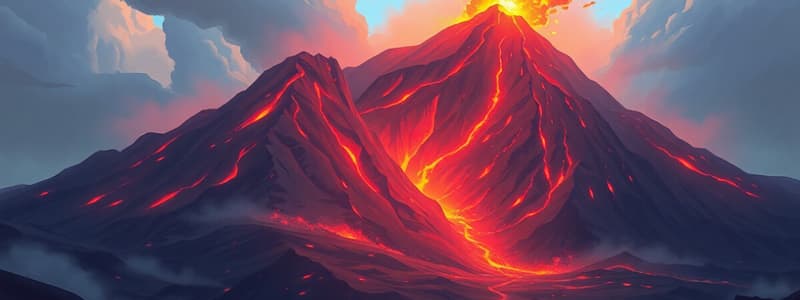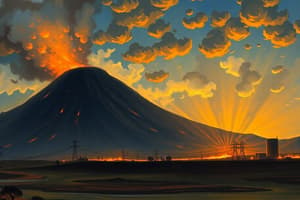Podcast
Questions and Answers
What defines a natural process?
What defines a natural process?
- A process produced by nature. (correct)
- A process that can only be gradual.
- A process that is always dangerous.
- A process caused by human activity.
Which of the following statements about natural hazards is true?
Which of the following statements about natural hazards is true?
- Natural hazards have natural causes that cannot be prevented. (correct)
- Natural hazards only occur in specific climates.
- Natural hazards always lead to disasters.
- Natural hazards can be predicted accurately.
How can volcanic eruptions impact habitats?
How can volcanic eruptions impact habitats?
- They can disrupt current habitats and create new land. (correct)
- They promote habitat diversity without disrupting existing ones.
- They only affect aquatic ecosystems.
- They only destroy habitats with no new land creation.
What is the main difference between magma and lava?
What is the main difference between magma and lava?
What role does Kilauea volcano play in the ecosystem of the Big Island of Hawaii?
What role does Kilauea volcano play in the ecosystem of the Big Island of Hawaii?
What can earthquakes centered near populated areas lead to?
What can earthquakes centered near populated areas lead to?
What occurred as a result of the 1980 eruption of Mount St. Helens?
What occurred as a result of the 1980 eruption of Mount St. Helens?
What happens when natural hazards become natural disasters?
What happens when natural hazards become natural disasters?
What is one of the causes of flooding mentioned?
What is one of the causes of flooding mentioned?
What is the primary purpose of floodgates?
What is the primary purpose of floodgates?
What technology is used to detect seismic activity that may trigger tsunamis?
What technology is used to detect seismic activity that may trigger tsunamis?
Which building characteristic is vital for earthquake safety?
Which building characteristic is vital for earthquake safety?
How do scientists predict volcanic eruptions?
How do scientists predict volcanic eruptions?
What significant impact can tsunamis have on populated areas?
What significant impact can tsunamis have on populated areas?
What is the role of advanced computer modeling in flood management?
What is the role of advanced computer modeling in flood management?
What is a primary reason for developing warning systems for natural hazards?
What is a primary reason for developing warning systems for natural hazards?
Why is building earthquake-resistant structures considered effective?
Why is building earthquake-resistant structures considered effective?
Which activity is most critical for reducing the impacts of all natural hazards?
Which activity is most critical for reducing the impacts of all natural hazards?
Flashcards are hidden until you start studying
Study Notes
Natural Processes and Natural Hazards
- Natural processes are events that happen in nature, some sudden, some gradual.
- Natural hazards are natural processes that have potentially negative impacts on people or the environment.
- Some areas are more susceptible to specific natural hazards than others.
Benefits of Natural Processes
- Volcanic lava can create new land, providing habitats for plants and animals.
Negative Impacts of Natural Processes
- Volcanic eruptions can destroy habitats, infrastructure, and cause harm to people, animals, and plants.
Types of Natural Hazards
- Earthquakes: Caused by movement of tectonic plates, leading to ground shaking and damage to structures.
- Flooding: Caused by heavy rainfall, snowmelt, and overflowing rivers, resulting in water damage and potential loss of life.
- Tsunamis: Triggered by underwater earthquakes, volcanic eruptions, or landslides, causing significant destruction along coastlines.
Reducing the Impact of Natural Hazards
- Flooding: Flood barriers and floodgates control water flow and prevent flooding. Advanced computer modeling predicts flooding locations and severity.
- Earthquakes: Earthquake-resistant buildings designed to withstand shaking are built, reducing damage and loss of life.
- Tsunamis: Satellite and buoy systems detect potential tsunamis and alert warning centers. Coastal mapping identifies high-risk areas. Public education and evacuation plans are developed.
- Volcanic Eruptions: Technological tools, like seismic monitoring, gas detection, and GPS, help predict eruptions and warn populations.
Technology's Role
- Technology plays a crucial role in mitigating natural hazards, providing early warnings, predicting events, and improving infrastructure resilience.
Key Threats
- The most critical impact of natural hazards is the danger to human lives.
- Advances in technology and warning systems aim to protect human lives and minimize damage.
Studying That Suits You
Use AI to generate personalized quizzes and flashcards to suit your learning preferences.




